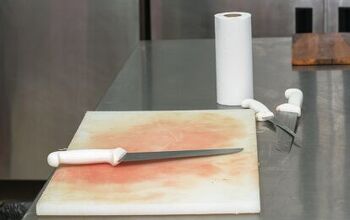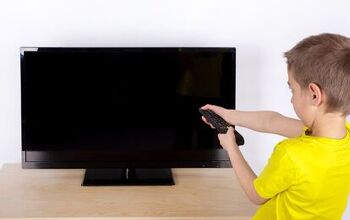How To Fix A TV After A Power Surge (Do This!)

Several things can cause a power surge in your home. One of the most common is lightning striking the power lines to your home. It may seem like it does not happen often, but it frequently causes billions of dollars of damage each year.
Every electronic inside your home is at risk during a power surge. This article will discuss what causes power surges, preventions, and what to do after the power surge. A TV is something you can reset after a power surge, and we will go through the steps.
Disconnect your TV, plug it back in, turn it on, select “Menu”, and find “Settings”. Scroll through options and find “Factory Reset” or “Restore to Default”. Let the TV power off and back on, then enter the settings and turn it back to your preferred settings after a power outage.
Do You Need TV or Home Theater Accessory Repair?
Get free, zero-commitment quotes from pro contractors near you.

What Causes a Power Surge and What Is it?
The National Lightning Safety Institute stated power surges cause $5 to $6 billion in damages every year to electronics. It is an unseen hazard that preventions and precautions can eliminate most of the damages. The statistics are staggering, and it happens quickly.
What is a Power Surge?
A power surge is an unavoidable and unexpected spike in the energy supply to the electrical outlets. Most of the electrical appliances in the home are 120 volts AC power. If an intense spike in power goes through the outlets with the items plugged in, problems arise.
Some problems people face are malfunctions, overheating, and fires in some situations. These are the several factors that can cause power surges.
1. Overloaded Circuits or Outlets
Electrical outlets are no different from appliances when they have their limits. If too many devices are connected to one outlet, it will send too much electricity to the area. When this happens, a power surge will take place.
If one room has all the electrical outlets on one circuit, the circuit can send a power surge, cutting off the power. You should contact an electrician if it continues to trip the breaker. One time is alright but constantly means there is a problem.
2. Exposed or Damaged Wires
Seeing exposed or damaged wires is a visual image of the problem. It is something that can easily get noticed. Exposed wires where the copper is sticking out can cause electricity to move unconfined throughout the home.
No one should have to explain how dangerous electricity is, but please get a professional to handle exposed wires. Power spikes can occur with exposed wires and cause a power surge.
3. Lightning
About 30 million lightning strikes hit the ground in America alone annually. It is pure electricity and is one of the most common spikes in surges. Do not believe the fairy tale “Lightning does not strike twice in the same place.”
Lightning does strike more than once in the same place. It has been proven in different locations across the world. If it hits the power lines at your location, be aware, it can happen again.
4. High-Energy Appliances
Appliances that take a lot of energy, such as air conditions, are notorious for causing power surges when turning on. A large amount of power is drawn from the circuitry, and electronics caught in the path are subject to damage. The best way to tell if power surges are a continual problem is if the lights are flickering.
5. Power Outages from the Power Company
It sounds funny, but no power going to your home can also cause a power surge. These types of surges are unavoidable because it comes directly from the source. The power company may experience a surge and lose power.
When the power kicks back on, surges are expected in different parts of the neighborhood. Not everyone will experience it, but it is something to be aware of when the power keeps going on and off.
Preventions and Precautions in Power Surges
Power surges are expected when electrical storms pass through. When the power company plays on and off with the electricity, it can get aggravating. The best way to prevent damages is to unplug all electrical appliances and devices.
As we discussed, all the surges pass through the outlets. Anything plugged into the wall will be at risk of damages. Purchasing power surge protectors for computers, TVs, and other electronics are a great way to salvage your equipment.
If you notice an issue with power surges, fix the overloaded circuits, and upgrade your wiring. This can help resolve the problem to where you do not have any damages. It can also save your home and your life from a fire.
One last option can protect your entire home. Installing a full house or building surge protector can save not only the electronics but the appliances too. It can save you from purchasing all new appliances and equipment, including powered garage doors and outdoor gear.
Fixing a TV After a Power Surge
A TV is one of the most prized possessions in a home. If a power surge catches you off guard, don’t panic. All may not be at a loss if you can reset the TV by following these steps.
Step 1: Test the TV By Testing the Outlet
Unplug the TV and plug something in the outlet where the TV is plugged. If the electronic device works, the outlet is working. Plug the TV back into its outlet, and if it does not work, there is an issue with your TV.
Step 2: Disconnect Everything from the TV
Unplug the TV and all the HDMI and other wires from the TV. Make sure everything has been disconnected.
Step 3: Begin Resetting the TV
Once everything has been disconnected, plug the TV back into the wall and turn it on. Press the “menu” button and hit “Settings.” If the TV does not work, jump to the last part of these steps, “What if my TV Does Not Work?”
Step 4: Convert TV to Default Settings
Under “Settings,” find “Advanced” or “Options” and click on it. Look for “Factory Default,” “Factory Reset,” or something that resembles it and click on it. When you click on it, the screen will ask if you want to continue or click the “Yes” option.
Step 5: Continue To Follow the TV’s Instructions
Once you hit the “Yes” or “Continue” button, your TV screen will go black. When the screen comes back on, it will show the main menu screen. You will then need to turn off the TV and reconnect all the cables in the back.
Step 6: Reset TV to Your Preferences
When you have everything reconnected, turn the TV back on and reset the TV to your preferences. If everything comes on properly, then you are good to watch all the TV you want. If the TV does not come back on, move on to step 7.
Step 7: What To Do If the TV Does Not Turn On
If the TV does not work after resetting the TV, the power supply board will need to be replaced. Unscrew the back of the TV, and you will see the board. Be sure to look for blown capacitors or burns.
If you see the board is black or fried, it will need to be replaced. You can go online and get the numbers off the board’s back and order a new one through the manufacturer. When the new power supply board comes in, install it, and the TV should work.
Do You Need TV or Home Theater Accessory Repair?
Get free, zero-commitment quotes from pro contractors near you.

What If My TV Does Not Work?
The only thing left is if you get standby/power lights, then the main video board is the problem. It will need to be replaced. Some situations will leave you changing both the main video and the power supply boards.
Everything is a trial and error when repairing a TV after a power surge. If you have tried everything listed in these steps, you cannot do much more yourself. It will take a service technician to repair the TV.
If it goes that far, be sure to get an estimate before any work is done on the TV. Sometimes the damage may be too far gone. In that situation, the repairs may cost more than a new TV.
Many times TVs are repairable after a power surge. The important thing is following the rules of safety when fixing all electronics.
More Related Guides

We are a team of passionate homeowners, home improvement pros, and DIY enthusiasts who enjoy sharing home improvement, housekeeping, decorating, and more with other homeowners! Whether you're looking for a step-by-step guide on fixing an appliance or the cost of installing a fence, we've here to help.
More by Upgraded Home Team

















![How To Reset A Whirlpool Cabrio Washer [In 5 Easy Steps!]](https://cdn-fastly.upgradedhome.com/media/2023/07/31/9076531/how-to-reset-a-whirlpool-cabrio-washer-in-5-easy-steps.jpg?size=350x220)









